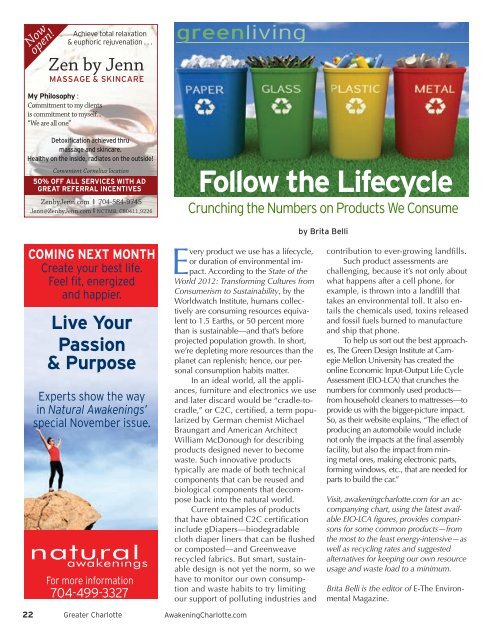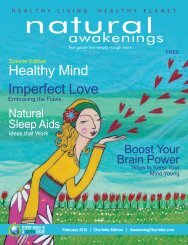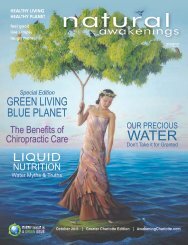October 2012 Issue - Natural Awakenings Magazine Charlotte
October 2012 Issue - Natural Awakenings Magazine Charlotte
October 2012 Issue - Natural Awakenings Magazine Charlotte
Create successful ePaper yourself
Turn your PDF publications into a flip-book with our unique Google optimized e-Paper software.
Now<br />
open!<br />
Achieve total relaxation<br />
& euphoric rejuvenation . . .<br />
Zen by Jenn<br />
MASSAGE & SKINCARE<br />
My Philosophy :<br />
Commitment to my clients<br />
is commitment to myself...<br />
“We are all one”<br />
Detoxification achieved thru<br />
massage and skincare.<br />
Healthy on the inside, radiates on the outside!<br />
Convenient Cornelius location<br />
50% OFF ALL SERVICES WITH AD<br />
GREAT REFERRAL INCENTIVES<br />
ZenbyJenn.com I 704-584-9745<br />
Jenn@ZenbyJenn.com I NCTMB, C80411,9226<br />
COMING NEXT MONTH<br />
Create your best life.<br />
Feel fit, energized<br />
and happier.<br />
Live Your<br />
Passion<br />
& Purpose<br />
Experts show the way<br />
in <strong>Natural</strong> <strong>Awakenings</strong>’<br />
special November issue.<br />
For more information<br />
704-499-3327<br />
greenliving<br />
Every product we use has a lifecycle,<br />
or duration of environmental impact.<br />
According to the State of the<br />
World <strong>2012</strong>: Transforming Cultures from<br />
Consumerism to Sustainability, by the<br />
Worldwatch Institute, humans collectively<br />
are consuming resources equivalent<br />
to 1.5 Earths, or 50 percent more<br />
than is sustainable—and that’s before<br />
projected population growth. In short,<br />
we’re depleting more resources than the<br />
planet can replenish; hence, our personal<br />
consumption habits matter.<br />
In an ideal world, all the appliances,<br />
furniture and electronics we use<br />
and later discard would be “cradle-tocradle,”<br />
or C2C, certified, a term popularized<br />
by German chemist Michael<br />
Braungart and American Architect<br />
William McDonough for describing<br />
products designed never to become<br />
waste. Such innovative products<br />
typically are made of both technical<br />
components that can be reused and<br />
biological components that decompose<br />
back into the natural world.<br />
Current examples of products<br />
that have obtained C2C certification<br />
include gDiapers—biodegradable<br />
cloth diaper liners that can be flushed<br />
or composted—and Greenweave<br />
recycled fabrics. But smart, sustainable<br />
design is not yet the norm, so we<br />
have to monitor our own consumption<br />
and waste habits to try limiting<br />
our support of polluting industries and<br />
22 Greater <strong>Charlotte</strong> Awakening<strong>Charlotte</strong>.com<br />
Follow the Lifecycle<br />
Crunching the Numbers on Products We Consume<br />
by Brita Belli<br />
contribution to ever-growing landfills.<br />
Such product assessments are<br />
challenging, because it’s not only about<br />
what happens after a cell phone, for<br />
example, is thrown into a landfill that<br />
takes an environmental toll. It also entails<br />
the chemicals used, toxins released<br />
and fossil fuels burned to manufacture<br />
and ship that phone.<br />
To help us sort out the best approaches,<br />
The Green Design Institute at Carnegie<br />
Mellon University has created the<br />
online Economic Input-Output Life Cycle<br />
Assessment (EIO-LCA) that crunches the<br />
numbers for commonly used products—<br />
from household cleaners to mattresses—to<br />
provide us with the bigger-picture impact.<br />
So, as their website explains, “The effect of<br />
producing an automobile would include<br />
not only the impacts at the final assembly<br />
facility, but also the impact from mining<br />
metal ores, making electronic parts,<br />
forming windows, etc., that are needed for<br />
parts to build the car.”<br />
Visit, awakeningcharlotte.com for an accompanying<br />
chart, using the latest available<br />
EIO-LCA figures, provides comparisons<br />
for some common products—from<br />
the most to the least energy-intensive—as<br />
well as recycling rates and suggested<br />
alternatives for keeping our own resource<br />
usage and waste load to a minimum.<br />
Brita Belli is the editor of E-The Environmental<br />
<strong>Magazine</strong>.







